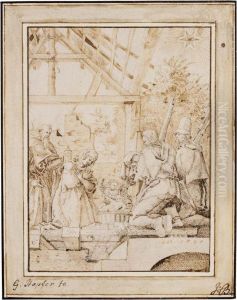Georg Hopfer Paintings
Georg Hopfer was a German artist and engraver who was active in the early 16th century. Born around 1490, Hopfer came from a family of artists; his brothers Daniel and Hieronymus Hopfer were also notable engravers. The Hopfer family lived and worked in Augsburg, a city that was a vibrant center for arts and commerce during the Renaissance period in Germany.
Georg Hopfer's work as an engraver placed him within the Northern Renaissance artistic movement, characterized by a great attention to detail and an emphasis on printmaking. The Hopfer brothers were known for their etchings on iron, a technique that was somewhat unusual at the time, as most other artists preferred to work with copper for printmaking. Etching on iron allowed for finer lines and a greater variation in textures, which contributed to the distinctiveness of their works.
There is limited information on the specifics of Georg Hopfer's life and career, but it is known that he produced a number of religious-themed works and ornamental designs. His engravings often featured elaborate patterns and were sometimes used as designs for armor and weaponry, reflecting the tastes and demands of the Renaissance clientele. The Hopfer brothers' prints were collected and replicated, indicating their popularity during the 16th century.
The exact date of Georg Hopfer's death is not known, but he is believed to have died sometime after 1536. His legacy, along with that of his brothers, has contributed to the understanding of printmaking techniques and the visual culture of the Renaissance in Germany. The works of the Hopfer family are held in various museum collections and continue to be studied by art historians for their technical skill and artistic innovation.
